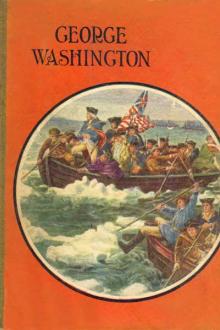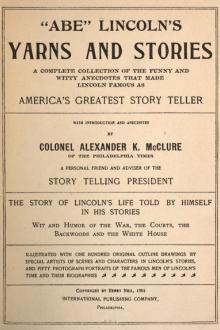The Civil War, James I. Robertson [good ebook reader TXT] 📗

- Author: James I. Robertson
- Performer: -
Book online «The Civil War, James I. Robertson [good ebook reader TXT] 📗». Author James I. Robertson
Conversely, Confederate officials were slow to use slaves as Southern soldiers. Many feared an uprising once the Negroes were given arms; others opposed the use of slaves as soldiers on grounds that the Negro was ill-prepared for such high responsibility. Not until March, 1865, when the war was almost over, did the Confederate government authorize the formation of Negro regiments. While some units were mustered into service, none were sent into combat.
To become a soldier, a man normally joined a military company being raised in his own locality. This company then went to a state training camp and joined similar units preparing for war. At the completion of basic training, ten companies were banded together as a regiment and mustered into national service. Orders came soon thereafter assigning the regiment to duty in the field.
Confederate winter quarters near Centreville, Va. The huts were constructed of logs, mud, and wood slabs.
The Federal private received $13 per month and a clothing allowance of $42 annually. Customarily, his uniform was dark blue and consisted of a kepi (a cap that slants toward the front), heavy wool coat, and lighter colored trousers. His prescribed equipment included rifle, ammunition, knapsack, blanket, haversack, canteen, bayonet, and cartridge box. The Federal lived mostly in a tent, cooked his meals with his messmates, and was personally responsible for the good condition of his equipment.
His Confederate counterpart was not so well provided. In addition to his musket, he normally carried a blanket slung over one shoulder, canteen, knife, and cartridge box. Gray was the color of the official Confederate uniform. However, few of the soldiers were uniformly clad after the first months of service. Many wore instead clothing taken from dead or captured Federals, or made at home and dyed in a solution of walnut hulls. The home-dyed uniform was light brown, or “butternut”, in color. Few tents existed in Confederate armies. Southern soldiers thus became accustomed to camping in the open. The Confederate private received $11 monthly until 1864, when his pay was raised to $18 because of widespread Southern inflation.
Photographer Timothy O’Sullivan captured this scene near Rappahannock Station, Va., in March, 1864. In the foreground is a sutler’s tent. The fence marks the stockade of the 50th New York Engineers.
The Federal soldier received much better rations than did the Confederate. His bread was a thick cracker called “hardtack”, and many jokes were made over its toughness. The Union soldier also received meat, dried vegetables, coffee, sugar, and salt. The Confederate soldier, unable to get coffee because of the blockade, learned to use beans, rye, parched corn, and even acorns as substitutes. Rarely did Southern troops have ample food. Personal accounts by Confederates often reveal pitiful instances of widespread malnutrition in the ranks.
For recreation, each soldier was left to his own devices. Letter-writing, reading, singing, card-playing, and sleeping were the favorite pastimes of troops in camp. In winter men on both sides constructed huts of logs and mud, or piled dirt against the sides of their tents as insulation from the cold. Reveille normally sounded at 5 a.m. in summer and 6 a.m. in winter. “Taps”, a melody first played in 1862, generally came between 10 and 11 p.m.
Fighting in the Civil War was generally savage, and guerrillas on both sides often killed in cold blood. Yet when opposing armies were camped close to one another, it was not at all uncommon for blue and gray pickets to establish informal truces, swap newspapers, tobacco, and coffee, and even to camp together. Sometimes this fraternization might last through an entire winter. Even in battle, many soldiers on both sides displayed great compassion—even to the extent of risking their lives in order to help a stricken foe. Sergeant Richard Kirkland of South Carolina was so overcome at the mounting Federal casualties during the battle of Fredericksburg that he crawled out upon the battlefield and voluntarily gave aid to dozens of wounded Northerners.
Noted Civil War artist Edwin Forbes sketched this scene of Federal and Confederate pickets between the lines swapping tobacco and coffee during a truce only they have declared.
Yet army life of the 1860’s had many and severe hardships. Improper diet and insanitary conditions often prostrated half of a unit’s membership. Since filth abounded in every army, a soldier who did not have his share of lice and fleas was a rare exception. Moreover, the fact that a majority of the soldiers were from rural communities made them very susceptible to such “city sicknesses” as measles, chicken pox, and small pox. The death rate from these diseases were very high. In the Federal armies, sickness and disease accounted for 7 of every 10 deaths. One authority has estimated that among the Confederates three men perished from disease for every man killed in battle. Small wonder that a Civil War soldier once wrote his family from camp: “It scares a man to death to get sick down here.”
Soldiers suffered too because of the limited medical knowledge of that day. Blood transfusions, X-rays, antibiotics, sterilization, vitamins, vaccines, wonder drugs all came after the Civil War. No assured treatment existed for typhoid fever, yellow fever, measles, or pneumonia, and great uncertainty prevailed over the proper way to stop a hemorrhage. Most bone fractures, and all wounds of the joint, meant amputation. In the Korean conflict of the 1950’s the chances of surviving a wound were 50-1; in the Civil War the chances were only 7-1.
That men of blue and gray endured these miseries is proof enough of their amazing capacity for hardships. Of greater importance to our American heritage, however, was their courage and devotion to duty. It shone forth on each side, and in every battle. Bell Irvin Wiley has commented:
“The Civil War was in large degree a soldier’s war. In that war the determination, self-sufficiency, and endurance of the individual in the ranks were of utmost importance. Officer casualties were heavy, and in the hurly-burly of combat those who survived often were able to exercise little control over their units. In the crucial, climactic stages of battle the common soldiers were to a large extent on their own, and it was often their courage and tenacity, individual and collective, that ultimately decided the contest.... For it was these men and their kind whose strength was the bedrock of their respective causes and whose greatness made their war one of the most inspiring in the history of embattled humanity.”
Co. G, 93rd New York Infantry, posed for this photograph at Bealeton, Va., in August, 1863. Note the drummer boy near the left of the bottom row.
Confederate troops on the march, as seen by Southern artist Allen C. Redwood.
SUGGESTED READINGS Billings, John D., Hardtack and Coffee (1888). Cornish, Dudley T., The Sable Arm (1956). Eggleston, George C., A Rebel’s Recollections (1887, 1959). Fay, Edwin H., This Infernal War, ed. Bell I. Wiley (1958). Higginson, Thomas W., Army Life in a Black Regiment (1870, 1962). Jones, Jenkins L., An Artilleryman’s Diary (1914). Lord, Francis A., They Fought for the Union (1960). McCarthy, Carlton, Detailed Minutiæ of Soldier Life in the Army of Northern Virginia (1882). Robertson, James I., Jr., The Stonewall Brigade (1963). Stillwell, Leander, The Story of a Common Soldier of Army Life in the Civil War, 1861-1865 (1920). Upson, Theodore F., With Sherman to the Sea (1943, 1958). Wiley, Bell I., The Life of Billy Yank (1952). ____, The Life of Johnny Reb (1943). ____, and Milhollen, Hirst D., They Who Fought Here (1960).The National Cemetery at Alexandria, Va., was one of the first government-maintained cemeteries established during the Civil War.
XI. THE WAR’S LEGACYPerhaps it was necessary for brother to fight brother to determine the course in history our nation would take. Tragedy often walks with greatness; it required a terrible war before America could continue with confidence down the road of progress. The Civil War was the watershed—both a beginning and an end—in our history, and many legacies of that war keep it ever-present in our thoughts.
The Civil War lives in battle names now so much a part of our heritage: Bull Run, Shiloh, Antietam, Fredericksburg, Stone’s River, Chancellorsville, Vicksburg, Gettysburg, Chickamauga, Atlanta, the Wilderness, and the Crater. These grounds, drenched in human blood, are as sacred as our most revered cemeteries.
—It lives in the crosses that mark the final resting places for thousands of American patriots. Most of these soldiers died in the flower of youth. We shall never know what contributions their numbers might have made to politics, literature, the sciences, the arts—to American life in general. In this respect was the conflict of the 1860’s a great calamity.
Acclaimed by many as the best likeness of “Stonewall” Jackson, this equestrian statue is on the grounds of the Manassas National Military Park.
—It lives in the many statues and monuments erected across our land. These stone images stand as silent sentries of our past. They are reminders of the cost of what today belongs to all Americans.
—It lives in the Congressional Medal of Honor, given birth by that war, and in Memorial Day, which sprang from the heartache caused by that war.
—It lives in the American Red Cross, whose origins date from Clara Barton and her tender nursing of wounded Federal soldiers.
—It lives in the songs given popularity by men of blue and gray: “Dixie,” “The Battle Hymn of the Republic,” “The Bonnie Blue Flag,” “The Battle Cry of Freedom,” “Lorena,” “The Yellow Rose of Texas,” “Maryland, My Maryland,” “When Johnny Comes Marching Home Again,” “Tenting Tonight on the Old Camp Ground,” “Home, Sweet Home,” and many others.
This 1862 Army Model was the first Congressional Medal of Honor ever struck. The present Medal is quite different from its predecessor.
—It lives in the extinction of slavery, which Robert E. Lee once termed a heavy impediment to the whole Southern people.
—It lives in the Thirteenth, Fourteenth, and Fifteenth Amendments to the U. S. Constitution, which promise equality without racial limitations.
—It lives most of all in the unity of the American people. Until 1860 it was customary to say “the United States are”. After 1865 it was more correct to say “the United States is”. Today we acknowledge this change by a phrase in the Pledge of Allegiance: “... one nation, under God, indivisible....”
The Civil War did preserve the old Union with all of its virtues and all of its defects. But at the same time, as Lincoln and others hoped, the war gave birth to something better: a new Union, stronger and more enduring. The idea of secession ended forever with the Southern Confederacy; the oneness of modern America became reality with Appomattox and Durham Station.
Therefore, one cannot and should not forget the tragedy, courage, and lessons of the Civil War. If we would overlook the 1860’s that endowed us with unity, we must also ignore the 1770’s that brought us freedom. For unity and freedom are the bedrocks on which America rests—just as they are our hopes for the years yet to come.
XII. SUGGESTED TOPICS FOR FURTHER DISCUSSION(1) Could the Civil War have been avoided? If so, how? If not, why not?
(2) What concrete goals was each side trying to attain in that war?
(3) How did North and South differ in way of life?
(4) List, in parallel columns, the viewpoints of each





Comments (0)